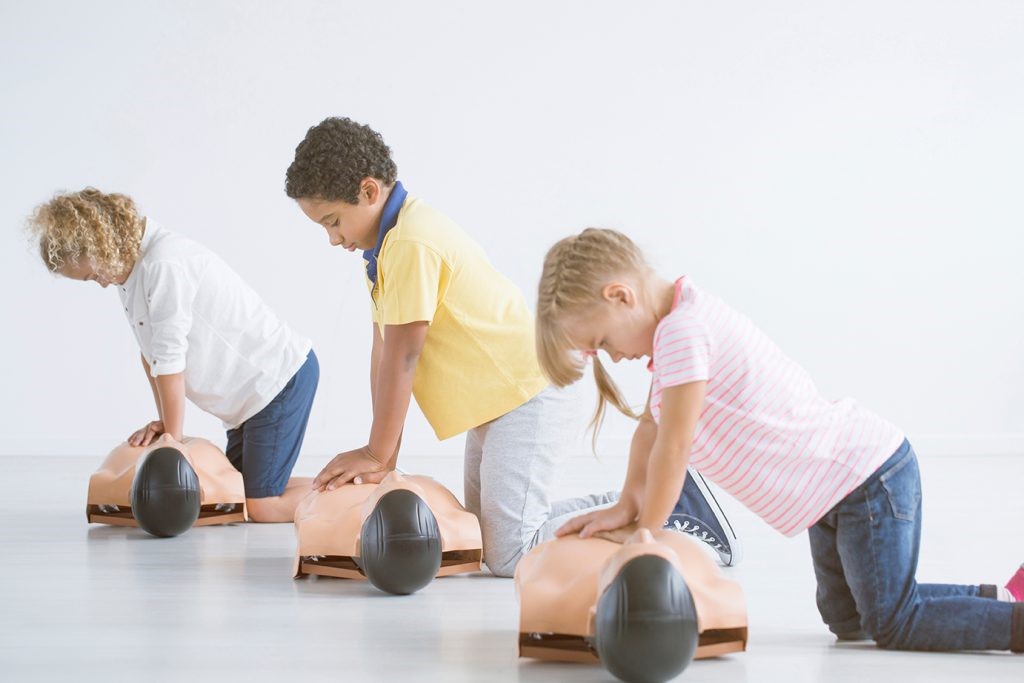
Why children should learn CPR: cardiopulmonary resuscitation at school age
Why Children Should Learn CPR: there is a common misconception that learning first aid and CPR are only meant for teenagers and adults. Wrong
According to studies, children as young as nine years old can learn and retain CPR lifesaving skills
Even though the younger ones don’t have the strength to carry out full chest compressions for long periods, they still have their cognitive skills to help.
What is CPR
Cardiopulmonary resuscitation (CPR) is a first aid technique used in emergencies where a person is not breathing properly or if their heart has stopped.
This technique involves chest compressions and mouth-to-mouth resuscitation (rescue breathes) to restore blood flow and improve oxygen circulation in the body.
Doing so will help keep the brain and vital organs alive until emergency help arrives.
Administering CPR in the first few minutes of an emergency is critical as brain damage can occur quickly when oxygen-rich blood cannot get into the brain.
Teaching lifesaving skills to children is one of the most powerful tools for reducing sudden cardiac arrest (SCA) fatalities.
The better trained a population is (regardless of age), the higher chances that a bystander will step in and perform lifesaving interventions to keep the victim alive until further help becomes available.
3 Reasons Why Children Should Learn CPR
When provided with the necessary skills, children and young teenagers can save lives even before reaching adulthood.
CHILD HEALTH: LEARN MORE ABOUT MEDICHILD BY VISITING THE BOOTH AT EMERGENCY EXPO
Here are 3 reasons why children should be more active in learning CPR.
- A great confidence booster
Providing children with short training sessions in CPR can improve their self-confidence.
This, in return, will lead to an increased will and ability to recognise and help in cardiac arrest emergencies.
They will consider themselves “able” to perform first aid intervention on a person suffering from a traumatic event.
In short, when a child believes and is confident in their own knowledge, they will dare to intervene.
- It helps save lives
Kids save lives.
We often hear this phrase in stories where young adults use their emergency training and knowledge to make a difference.
There are many instances like these where children save the lives of others through their physical or cognitive skills in doing first aid procedures.
For this reason, the resuscitation council recommends that children learn a range of lifesaving skills they can use at home, in school, and community. In addition to CPR, kids can also learn how to stop a bleed, help a choking victim, and operate an AED (for older children).
- It promotes a sense of safety
Out of many injuries involving children, the highest rate of occurrence is usually at home.
A kid who is trained in CPR can help mitigate the situation by knowing the dos and don’ts.
Knowing CPR and first aid basics also promotes awareness, which gives them an overall sense of safety.
Read Also:
Emergency Live Even More…Live: Download The New Free App Of Your Newspaper For IOS And Android
CPR And Neonatology: Cardiopulmonary Resuscitation In The Newborn
Resuscitation Manoeuvres: Cardiac Massage On Children
What Is The Difference Between Adult And Infant CPR
Why Sports Coaches Need First Aid Training
Defibrillator: What It Is, How It Works, Price, Voltage, Manual And External
The Patient’s ECG: How To Read An Electrocardiogram In A Simple Way
Emergency, The ZOLL Tour Kicks Off. First Stop, Intervol: Volunteer Gabriele Tells Us About It
Proper Defibrillator Maintenance To Ensure Maximum Efficiency
Signs And Symptoms Of Sudden Cardiac Arrest: How To Tell If Someone Needs CPR
Drowning Resuscitation For Surfers
First Aid: When And How To Perform The Heimlich Maneuver / VIDEO
Mild, Moderate, Severe Mitral Valve Insufficiency: Symptoms, Diagnosis And Treatment
First Aid, The Five Fears Of CPR Response
Perform First Aid On A Toddler: What Differences With The Adult?


